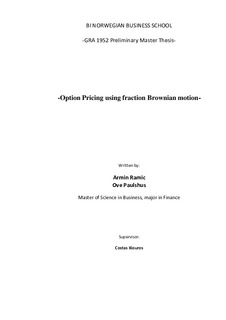| dc.description.abstract | This thesis examines the empirical properties of a fractional Black and Scholes model
developed by Röstek and Schobel. The model is tested and compared to the standard Black
and Scholes for Standard and Poor’s 500 call options in the period 10th May to 10th of July
2018. We first go through the theoretical differences of using a geometrical and a fractional
Brownian motion. We test the models using three different empirical tests, following the
methods of Bakshi, Cao & Chen (1997). The performance is measured using an in-sample
test, an out of sample test and running a dynamic delta hedging strategy over a period of 41
trading days. While testing the models, we highlight the importance of estimating the correct
Hurst value (long-term dependence) as the model becomes time dependent. We find that the
fractional Black and Scholes model is misspecified, but performs slightly better in the out of
sample test. In total, we rank the fractional equal to the geometric model. | nb_NO |

